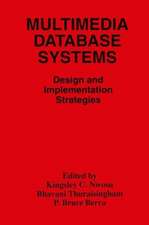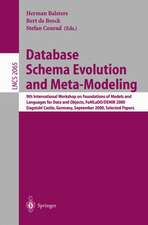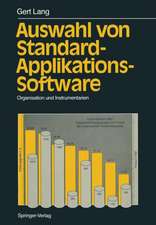Developing Information Systems Accurately: A Wholistic Approach
Autor Bert de Brocken Limba Engleză Paperback – 28 apr 2023
The book consists of two parts: Part I presents the underlying theory while Part II contains various illustrative case studies. Part I starts with an introduction to the topic (Chapter 1). Then it explains how to develop functional requirements that represent the conceptual dynamics of an information system (Chapters 2 and 3). Chapters 4 and 5 explain how to model the conceptual statics of an information system. Chapter 6 gives some directions for implementation. Finally, Chapter 7 explains how a ‘technical manager’ can organize and manage the development process.
As an illustration of the theory, Part II contains three substantial case studies. The first one (Chapter 8) presents a stepwise development starting from an informal situation sketch via a simple domain model towards a precisely specified, full-fledged conceptual data model, which finally is translated to an SQL database. In the second case study (Chapter 9) the author converts the well-known non-trivial use case Process Sale from Larman into a textual System Sequence Description (SSD). For validation purposes, that textual SSD is subsequently translated into natural language and into a graphical SSD. The third case study (Chapter 10) shows the applicability of the author’s approach to a control system and also illustrates the typical situation that the requirements are constantly changing during development.
This book is written for (under)graduate students in software engineering or information systems who want to learn how to carry out adequate problem analysis, to make good system specifications, and/or to understand how toorganize and manage an IS-development process. It also targets practitioners who want to improve their problem analysis abilities and/or their ability to make good system specifications. To this end, it includes more than 150 explanatory figures and is accompanied by a Web site which provides additional course material such as slides, additional exercises, solutions to exercises, and the code for the figures used in the book.
Preț: 337.64 lei
Preț vechi: 422.05 lei
-20% Nou
Puncte Express: 506
Preț estimativ în valută:
64.61€ • 67.45$ • 53.47£
64.61€ • 67.45$ • 53.47£
Carte disponibilă
Livrare economică 14-28 martie
Livrare express 27 februarie-05 martie pentru 28.92 lei
Preluare comenzi: 021 569.72.76
Specificații
ISBN-13: 9783031168611
ISBN-10: 3031168615
Pagini: 252
Ilustrații: XXV, 252 p. 141 illus., 25 illus. in color.
Dimensiuni: 155 x 235 x 18 mm
Greutate: 0.4 kg
Ediția:1st ed. 2023
Editura: Springer International Publishing
Colecția Springer
Locul publicării:Cham, Switzerland
ISBN-10: 3031168615
Pagini: 252
Ilustrații: XXV, 252 p. 141 illus., 25 illus. in color.
Dimensiuni: 155 x 235 x 18 mm
Greutate: 0.4 kg
Ediția:1st ed. 2023
Editura: Springer International Publishing
Colecția Springer
Locul publicării:Cham, Switzerland
Cuprins
- 1. Introduction. - Part I Theory. - 2. Developing a Functional Requirement. - 3. Development Patterns. - 4. Domain Modelling. - 5. Conceptual Data Models. - 6. Directions for Implementation. - 7. Organizing and Managing the Development Process. - Part II Case Studies. - 8. A Non-trivial University Example Worked Out. - 9. Converting a Large Use Case. - 10. Development Example Where Requirements Constantly Change.
Notă biografică
Bert de Brock is Professor Emeritus of Business Information Modelling at the Faculty of Economics and Business of the University of Groningen, The Netherlands, a position he held for 15 years. Prior to that, he was Associate Professor of Information Technology, in particular Software Engineering, for more than 10 year.
Before moving into academia, Bert had worked as a senior researcher at Philips Research, e.g. developing generators for generic workflow software; and he had been founder, owner, and director of Remmen & De Brock, a software and consultancy firm specialized in requirements engineering and designing and building dedicated information systems for various customers.
Bert has taught Information Systems Development, Databases, Business Intelligence, E-venturing, and Programming for several decades, both to students and to practitioners.
Before moving into academia, Bert had worked as a senior researcher at Philips Research, e.g. developing generators for generic workflow software; and he had been founder, owner, and director of Remmen & De Brock, a software and consultancy firm specialized in requirements engineering and designing and building dedicated information systems for various customers.
Bert has taught Information Systems Development, Databases, Business Intelligence, E-venturing, and Programming for several decades, both to students and to practitioners.
Textul de pe ultima copertă
This textbook shows how to develop the functional requirements of (information) systems. It emphasizes the importance to consider the complete development path of a functional requirement, i.e. not only the individual development steps but also their proper combination and their alignment.
The book consists of two parts: Part I presents the underlying theory while Part II contains various illustrative case studies. Part I starts with an introduction to the topic (Chapter 1). Then it explains how to develop functional requirements that represent the conceptual dynamics of an information system (Chapters 2 and 3). Chapters 4 and 5 explain how to model the conceptual statics of an information system. Chapter 6 gives some directions for implementation. Finally, Chapter 7 explains how a ‘technical manager’ can organize and manage the development process.
As an illustration of the theory, Part II contains three substantial case studies. The first one (Chapter 8) presents a stepwise development starting from an informal situation sketch via a simple domain model towards a precisely specified, full-fledged conceptual data model, which finally is translated to an SQL database. In the second case study (Chapter 9) the author converts the well-known non-trivial use case Process Sale from Larman into a textual System Sequence Description (SSD). For validation purposes, that textual SSD is subsequently translated into natural language and into a graphical SSD. The third case study (Chapter 10) shows the applicability of the author’s approach to a control system and also illustrates the typical situation that the requirements are constantly changing during development.
This book is written for (under)graduate students in software engineering or information systems who want to learn how to carry out adequate problem analysis, to make good system specifications, and/or to understand how to organize and manage anIS-development process. It also targets practitioners who want to improve their problem analysis abilities and/or their ability to make good system specifications. To this end, it includes more than 150 explanatory figures and is accompanied by a Web site which provides additional course material such as slides, additional exercises, solutions to exercises, and the code for the figures used in the book.
The book consists of two parts: Part I presents the underlying theory while Part II contains various illustrative case studies. Part I starts with an introduction to the topic (Chapter 1). Then it explains how to develop functional requirements that represent the conceptual dynamics of an information system (Chapters 2 and 3). Chapters 4 and 5 explain how to model the conceptual statics of an information system. Chapter 6 gives some directions for implementation. Finally, Chapter 7 explains how a ‘technical manager’ can organize and manage the development process.
As an illustration of the theory, Part II contains three substantial case studies. The first one (Chapter 8) presents a stepwise development starting from an informal situation sketch via a simple domain model towards a precisely specified, full-fledged conceptual data model, which finally is translated to an SQL database. In the second case study (Chapter 9) the author converts the well-known non-trivial use case Process Sale from Larman into a textual System Sequence Description (SSD). For validation purposes, that textual SSD is subsequently translated into natural language and into a graphical SSD. The third case study (Chapter 10) shows the applicability of the author’s approach to a control system and also illustrates the typical situation that the requirements are constantly changing during development.
This book is written for (under)graduate students in software engineering or information systems who want to learn how to carry out adequate problem analysis, to make good system specifications, and/or to understand how to organize and manage anIS-development process. It also targets practitioners who want to improve their problem analysis abilities and/or their ability to make good system specifications. To this end, it includes more than 150 explanatory figures and is accompanied by a Web site which provides additional course material such as slides, additional exercises, solutions to exercises, and the code for the figures used in the book.
Caracteristici
Shows how to develop the functional requirements of (information) systems along their complete development path Includes three substantial case studies that show how to successfully apply the presented methodology in practice Accompanied by a Web site which provides additional course material such as slides, exercises, and solutions


























